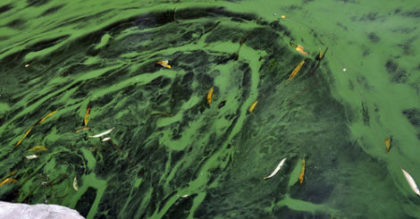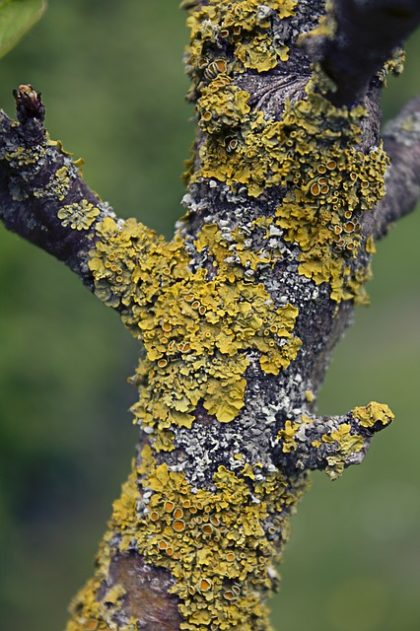
 )
)Since I’m at the beach this week, it seems like a good time to leave you with a review of Ruth Kassinger’s Slime, a broad survey of all the ways scientists and entrepreneurs are solving problems with algae. Algae have the potential to help us feed more people and provide better nutrition, to fuel transportation at personal and industrial scales, and to help clean up some of the environmental messes we’ve made. More than once while reading the book you may sense that algae sound too good to be true. Kassinger is clearly enthusiastic; at the same time, she is frank about the commercial struggles and failures algae businesses have already faced. Most of the projects she describes are in proof-of-concept or prototype stages and have significant hurdles to overcome if they are to scale to the point of global impact. Still, the opening chapters remind us that algae have already shaped the world several times over, so their potential is not entirely theoretical.
Algae is a broad label; it can refer to a variety of microscopic (e.g. plankton) and macroscopic (e.g. seaweed) eukaryotic organisms–meaning they have a nucleus and cellular organization similar to humans. Kassinger also includes cyanobacteria with algae, although that is a more informal usage. Cyanobacteria are not eukaryotic; their cells do not have nuclei or other membrane-bound internal compartments. They are bacteria which have the distinctive ability to carry out photosynthesis, which means they can use sunlight directly as a metabolic energy source. Eukaryotic algae are also photosynthetic. The significant interest in algae stems from this skill. In very broad and crude terms, if you feed algae sunlight and carbon dioxide, you can get out food for humans & animals, fertilizer for plants, and oil for transportation fuel. As a bonus, you take carbon dioxide out of the atmosphere.
Cyanobacteria removing carbon dioxide from the atmosphere and putting out oxygen is how we got an oxygen-rich atmosphere on Earth in the first place. Oxygen is very reactive chemically and so doesn’t tend to stick around by itself. As a result, the early Earth atmosphere had negligible amounts, as any oxygen that was around quickly reacted to form other compounds like carbon dioxide. Abundant carbon dioxide and sunlight were a boon to cyanobacteria, which flourished to the point that they were releasing oxygen in sufficient quantities that it could not all react right away and thus persisted. Cyanobacteria, eukaryotic algae, and plants continue to supply a steady stream of oxygen, making oxygen respiration a viable way of life for a whole host of living things, including eventually us.

 )
)Algae also contributed significantly to the existence of soil on the surface of the Earth. The early Earth was pretty rocky. Then algae combined with fungi to form lichens, which grow on rocks and slowly break them apart. The tiny bits of mineral-rich rock and organic-rich dead lichens accumulated to form the basis of the soil we rely on today to grow our crops. So while we humans largely just imagine the ability to terraform a lifeless planet into a habitat amenable to thriving ecosystems of which we are a part, cyanobacteria and algae have already accomplished that feat several times over.
Thus, some optimism about algae transforming our food and our fuel is warranted. Seaweed is already a staple of some diets in coastal communities. Algae are already removing unwanted chemicals from waterways and carbon dioxide from the atmosphere. And dead algae are already a significant portion of fossil fuels. We just need to work out how to scale all of these processes up to address our global needs. Some challenges are technical; for example, oil made from algae needs to be separated from the algae itself to make fuel compatible with existing infrastructure. Other challenges are economic; fossil fuels benefit from an economy of scale due to arriving first and having all of that infrastructure built out to accommodate them. Algae fuels and foods cannot currently compete on price. Still, science is making progress on the technical challenges and factoring in the full cost of fossil fuels may persuade more folks that algae are economically competitive.
You may have noticed the subtitle included “Plague Us.” Outside of our labs and start-up algae farms, algae are still having a global impact but it is not entirely positive for us. Warmer oceans, more carbon dioxide in the atmosphere, and more nutrients like nitrogen and phosphorus in the water from agricultural fertilizer runoff all create environments in which algae flourish. Sometimes they flourish so much that it is a detriment to all other organisms. Algal blooms have been in the news lately, closing bodies of water from recreational activity because the large quantities of algae are making large quantities of toxins. Nontoxic blooms can also cause problems. When the algae die en masse bacteria consume them and use up oxygen in the process; these leaves large swathes of lakes and oceans low on oxygen for fish, crabs and all other aquatic life. These “dead zones” disrupt ecosystems and reduce fish and seafood available for human consumption. Seaweed can also bloom. Many beaches along the Atlantic Ocean are seeing record amounts of seaweed washing up from a massive bloom this year. In some cases the sheer volume alone is closing beaches; there are no toxic effects to worry about, but there is just no room on the sand for people.
Still, even these negative (from our perspective) consequences illustrate the substantial power algae have in aggregate to influence the environment on a global scale. With significant investment, a lot of ingenuity, and careful oversight to detect and mitigate unintended consequences early, we can leverage that power to be better neighbors to our fellow humans and better stewards of the Earth. Kassinger’s book is a great introduction to the science behind that power and the current state of our relationship with algae.
Andy has worn many hats in his life. He knows this is a dreadfully clichéd notion, but since it is also literally true he uses it anyway. Among his current metaphorical hats: husband of one wife, father of two teenagers, reader of science fiction and science fact, enthusiast of contemporary symphonic music, and chief science officer. Previous metaphorical hats include: comp bio postdoc, molecular biology grad student, InterVarsity chapter president (that one came with a literal hat), music store clerk, house painter, and mosquito trapper. Among his more unique literal hats: British bobby, captain’s hats (of varying levels of authenticity) of several specific vessels, a deerstalker from 221B Baker St, and a railroad engineer’s cap. His monthly Science in Review is drawn from his weekly Science Corner posts — Wednesdays, 8am (Eastern) on the Emerging Scholars Network Blog. His book Faith across the Multiverse is available from Hendrickson.

Leave a Reply